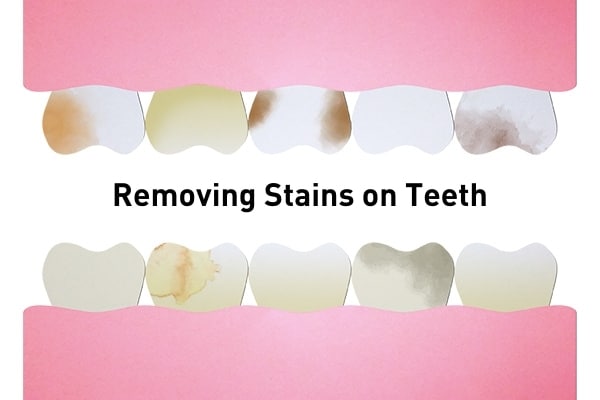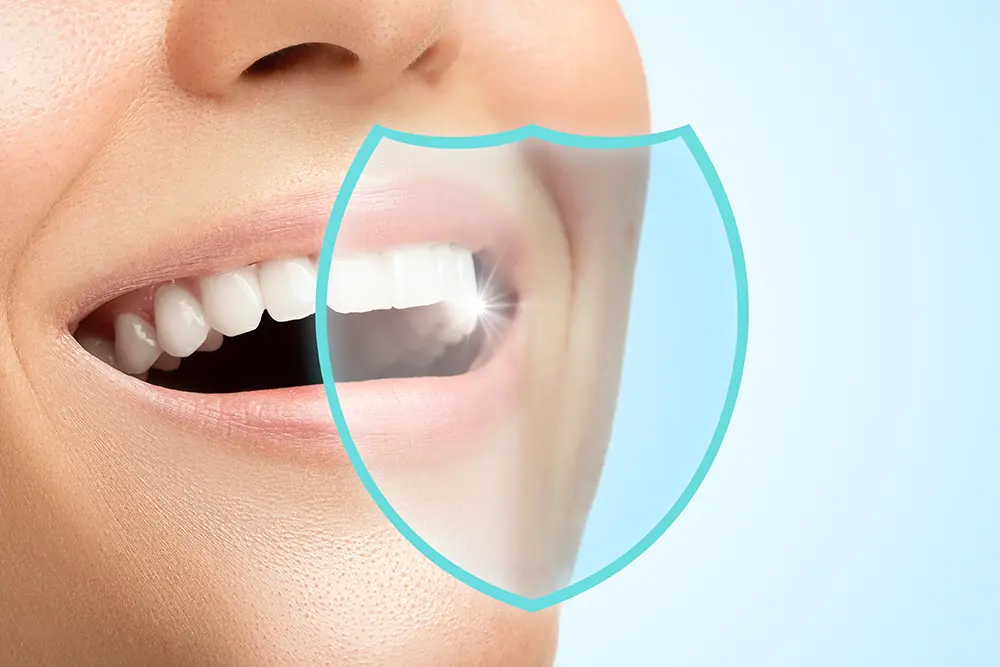Stains or discolouration on the teeth can affect the smile. It’s a common problem many of us face and can often cause irritation or embarrassment.
However, not all stains are created equal. There are many different types of teeth discolourations, such as brown stains, white spots, bands or evenly yellow teeth.
The good news is that there are several ways to remove teeth stains or cover them up. Thus, it helps to understand the nature of the stains to deal with them effectively.
What Are The Types of Teeth Stains?
Stains can be categorised into extrinsic and intrinsic ones. Extrinsic stains are stains that collect on the surfaces of teeth, as highly-coloured food and drinks can leave deposits on our teeth.
Intrinsic stains occur when the tooth structure itself is penetrated by a discolouring agent.
Common examples of extrinsic stains are:
1. Tea and coffee leaving brown to black deposits on teeth. These can be difficult to remove, especially from the pits and grooves on our teeth.

2. Smoking/tobacco use produces a yellowish-brown to black discolouration. The stains often collect in between teeth and on the back surfaces of the teeth (facing the tongue).
What’s the Difference in Removing External vs Internal Teeth Stains?
Removing Extrinsic Stains
Extrinsic stains can be removed by visiting your dentist for scaling and polishing. Stains are removed during the process of polishing, often achieved by using a polishing cup as well as a polishing jet.
Removing Intrinsic Stains
As the name suggests, the stains are “ingrained” and are more difficult to remove than surface stains. Cleaning alone would not have any success in removing intrinsic stains. Thus, let’s look at the different causes of intrinsic stains and methods for removing them.
Stain Removal for Different Causes of Intrinsic Stains
1. Tetracycline Stains
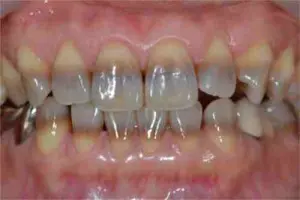
Sometimes called antibiotic staining, this occurs when tetracycline particles are incorporated into the dentine of teeth during their formation. This can happen anytime from the second trimester in utero to 8 years of age. Since the colour is part of the tooth’s structure, it cannot be removed and will not fade with time.
Mild tetracycline staining manifests as a yellow and light grey discolouration, while more severe cases are characterised by a dark grey or blue discolouration, often appearing in bands.
How to Remove Tetracycline Stains

Mild to moderate tetracycline stains respond well to professional teeth whitening performed by dentists with hydrogen peroxide. Thus, a combination of in-clinic whitening and take-home whitening kits can yield good results over time.
However, severe cases may not respond to whitening treatment. In this case, the affected areas may need to be physically covered with ceramic veneers or crowns to cover up the stains.
2. Fluorosis
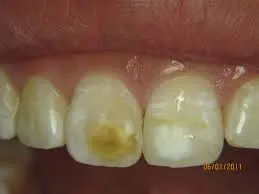
Fluorosis is a common phenomenon in areas where there is a higher fluoride content in the drinking water, such as in Singapore. Fluoride is beneficial in preventing dental caries (tooth decay).
However, the ingestion of fluoride by children during the development of enamel can result in white patches or streaks on teeth, sometimes coupled with yellow or brown lines or patches. This cosmetic condition is called fluorosis. Although it’s harmless, it may affect the look of a smile.
How to Remove Stains from Fluorosis

Fluorosis can be treated well with Icon infiltration, which is a technique using a fluid resin on affected enamel to achieve an optical masking effect. The dentist will apply the tooth-coloured resin to fill and cover the discoloured spots. This technique can give beautiful results when combined with whitening.
3. Caries (Tooth Decay)
Tooth decay is the result of constant acid attack on teeth surfaces produced by bacteria in the mouth. Early stages cause tooth enamel to lose its sheen and appear as white or brown spots/patches.

As tooth decay progresses, a cavity forms, appearing as a dark brown or black crater. A cavity on one side of a tooth can also appear as a dark grey shadow when seen from the opposite side.
Removing Spots from Caries (Tooth Decay)
Icon infiltration (see above) may be able to treat less extensive white or brown spots without cavities. That will cover the spots and also prevent tooth decay from worsening. This helps prevent the need for fillings in the future.
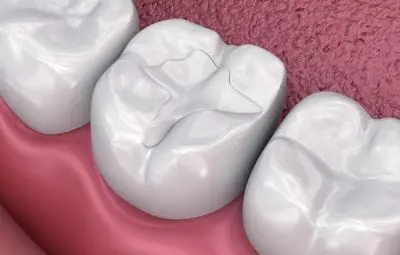
On the other hand, if you have cavities, they have to be treated with fillings. There are modern tooth-coloured materials which can achieve fillings that blend well with enamel and appear “invisible”.
4. Old Fillings
The source of teeth discolouration can be your existing fillings. Here are some common problems we see in patients:
- A poorly contoured or poorly polished filling can pick up and trap stains more quickly than the tooth around it.
- Leaking fillings will appear to have a brown or black border where the filling meets the tooth.
- Recurrent tooth decay under fillings can produce grey shadows in the teeth.
- Old metallic fillings can cause the surrounding tooth to stain grey.
Removing Discolourations from Old Fillings
You may have to remove problematic fillings to solve problems with stains or discolouration. The dentist may place new fillings to replace defective or unsightly fillings.
For the new fillings, you can opt for modern materials. They can produce fillings that look just like teeth when used with proper technique.
5. Age
It is common for teeth to look more yellow or darker with age. This is usually due to a combination of factors:
- Wearing down or thinning of the outer translucent enamel, which increases the prominence of the underlying yellow dentine.

- Increased dentine thickness through the formation of extra dentine throughout life creates a darker yellow appearance. The dentine is the inner, yellow layer of your tooth. Thus, your teeth appear yellower when dentine is thicker or when outside enamel is thinner.
- Years of cumulative staining effect of food and drink (especially items mentioned in Extrinsic Stains, such as tea and coffee).
- Often, old and leaking fillings also contribute to the overall discolouration.
Removing Discolourations from Age-related Problems
Generally, yellower teeth in older persons respond well to teeth whitening. Extrinsic stains from food and drink can be removed with scaling and polishing as well. Lastly, the dentist can replace defective or discoloured fillings.
In Conclusion
The solutions for getting rid of stains and discolourations on teeth depend on their causes. Getting regular scaling and polishing keeps your teeth free from external stains from food, drinks and smoking. However, no amount of cleaning can whiten intrinsically stained teeth!
Teeth can acquire intrinsic stains due to tetracycline staining, fluorosis, caries, old/problematic fillings, or age. These can cause white/brown spots, discolourations, or yellow-looking teeth.
Depending on the cause, you can opt for teeth whitening, icon infiltration treatment, or even veneers and crowns to cover the stains for a whiter, more even smile.
If you’re looking for treatment for stained or discoloured teeth, you can book an appointment with our friendly dentists today.

